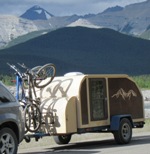I’m sure there is a post on this somewhere. I have read a few posts on building the cabin separate from the chassis and then connect it after it’s built. So my question is how do you connect it? What is the best way? Lag bolts? I thought about U clamps too.
Do I screw through the frame of the chassis? Any info would be appreciated. Photos even better, I’m a visual person lol.
Thanks everyone!
James
Attaching the cabin to the chassis
10 posts
• Page 1 of 1
Re: Attaching the cabin to the chassis
I actually built mine so it is removable. Not something you want to do all the time, but I take the camper off in the fall and put it back on once all the spring chores are done with the trailer (hauling shingles this week, then firewood) For the hold down, I have it bolted at/near all 4 corners. I took a few inches of steel strap (about 1/8 x 3/4") and drilled a couple holes in it. I then inserted 1/4" bolts and tack welded those in place. So it resembles a U bolt but is pretty much flat on top. I put the 4 of those in place and then crawl under the trailer and do up the nylock nuts. There is no need to have the wife hold a wrench on the top of the bolts as they are welded to the steel strap.
You can see some pictures here: http://tnttt.com/viewtopic.php?t=61318
You can see some pictures here: http://tnttt.com/viewtopic.php?t=61318
-

drhill - Teardrop Master
- Posts: 185
- Images: 37
- Joined: Wed Nov 06, 2013 5:00 pm
- Location: Calgary, AB





 , but I always say if it doesn't take anymore effort to do something with a little logical thinking behind it than it does to toss a dart and see what you get, then why not put a little thought into the process.
, but I always say if it doesn't take anymore effort to do something with a little logical thinking behind it than it does to toss a dart and see what you get, then why not put a little thought into the process.